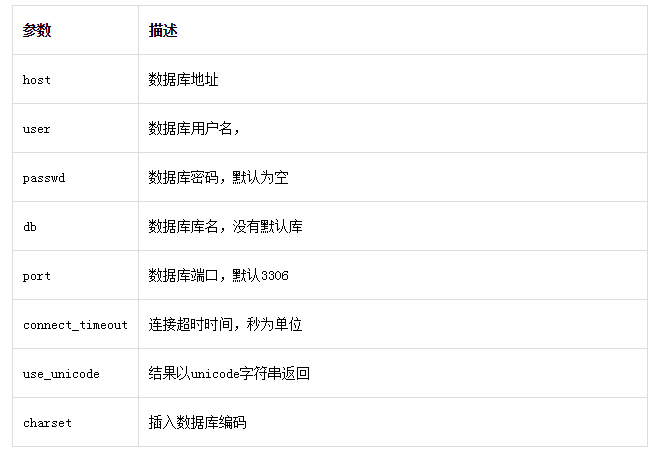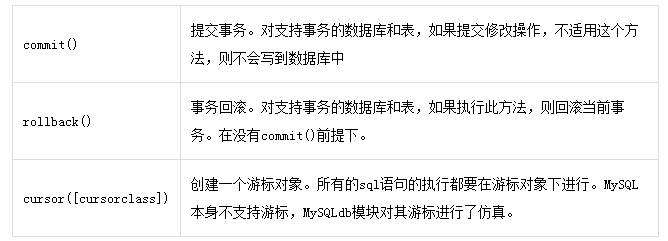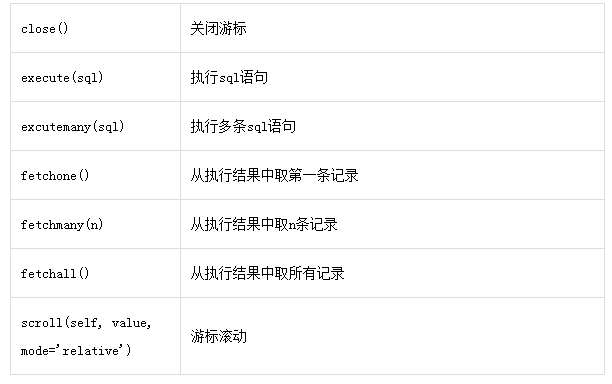Home > Article > Backend Development > Python database programming
Explain how Python operates a database and completes simple additions, deletions, modifications, and searches, taking the MySQL database as an example.
Python’s MySQL database operation module is called MySQLdb and requires additional installation.
Installation through pip tool: pip install MySQLdb
MySQLdb module, we mainly use the method MySQLdb.Connect() to connect to the database. After connecting to the database, we use some methods to perform corresponding operations. The
MySQLdb.Connect(parameters...) method provides the following commonly used parameters:

The connect() function returned by the connection object:

The cursor object also provides several methods:

13.1 Database addition, deletion and modification query
13.1.1 Create a user table in the test library and add a record
>>> conn = MySQLdb.Connect(host='192.168.1.244',user='root',passwd='QHyCTajI',db='test',charset='utf8')
>>> cursor = conn.cursor()
>>> sql = "create table user(id int,name varchar(30),password varchar(30))"
>>> cursor.execute(sql) # 返回的数字是影响的行数
0L
>>> sql = "insert into user(id,name,password) values('1','xiaoming','123456')"
>>> cursor.execute(sql)
1L
>>> conn.commit() # 提交事务,写入到数据库
>>> cursor.execute('show tables') # 查看创建的表
1L
>>> cursor.fetchall() # 返回上一个游标执行的所有结果,默认是以元组形式返回
((u'user',),)
>>> cursor.execute('select * from user')
1L
>>> cursor.fetchall()
((1L, u'xiaoming', u'123456'),)13.1.2 Insert multiple pieces of data
>>> sql = 'insert into user(id,name,password) values(%s,%s,%s)'
>>> args = [('2','zhangsan','123456'), ('3','lisi','123456'),('4','wangwu','123456')]
>>> cursor.executemany(sql, args)
3L
>>> conn.commit()
>>> sql = 'select * from user'
>>> cursor.execute(sql)
4L
>>> cursor.fetchall()
((1L, u'xiaoming', u'123456'), (2L, u'zhangsan', u'123456'), (3L, u'lisi', u'123456'), (4L, u'wangwu', u'123456'))The args variable is a list containing tuples, each tuples corresponding to each record. When querying multiple records, using this method can effectively improve insertion efficiency.
13.1.3 Delete the record of user name xiaoming
>>> sql = 'delete from user where name="xiaoming"' >>> cursor.execute(sql) 1L >>> conn.commit() >>> sql = 'select * from user' >>> cursor.execute(sql) 3L >>> cursor.fetchall() ((2L, u'zhangsan', u'123456'), (3L, u'lisi', u'123456'), (4L, u'wangwu', u'123456'))
13.1.4 Query the record
>>> sql = 'select * from user' >>> cursor.execute(sql) 3L >>> cursor.fetchone() # 获取第一条记录 (2L, u'zhangsan', u'123456') >>> sql = 'select * from user' >>> cursor.execute(sql) 3L >>> cursor.fetchmany(2) # 获取两条记录 ((2L, u'zhangsan', u'123456'), (3L, u'lisi', u'123456'))
13.1.4 Return the results in dictionary form
默认显示是元组形式,要想返回字典形式,使得更易处理,就用到cursor([cursorclass])中的cusorclass参数。
传入MySQLdb.cursors.DictCursor类:
>>> cursor = conn.cursor(MySQLdb.cursors.DictCursor)
>>> sql = 'select * from user'
>>> cursor.execute(sql)
3L
>>> cursor.fetchall()
({'password': u'123456', 'id': 2L, 'name': u'zhangsan'}, {'password': u'123456', 'id': 3L, 'name': u'lisi'}, {'password': u'123456', 'id': 4L, 'name': u'wangwu'})13.2 Traverse the query results
#!/usr/bin/env python
# -*- coding: utf-8 -*-
import MySQLdb
try:
conn = MySQLdb.Connect(host='127.0.0.1', port=3306, user='root', passwd='123456', connect_timeout=3, charset='utf8')
cursor = conn.cursor()
sql = "select * from user"
cursor.execute(sql)
for i in cursor.fetchall():
print i
except Exception, e:
print ("Connection Error: " + str(e))
finally:
conn.close()
# python test.py
(2L, u'zhangsan', u'123456')
(3L, u'lisi', u'123456')
(4L, u'wangwu', u'123456')Use a for loop to traverse the query results and add Exception handling.